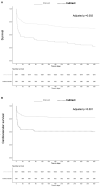Indirect Transfer to Catheterization Laboratory for ST Elevation Myocardial Infarction Is Associated With Mortality Independent of System Delays: Insights From the France-PCI Registry
- PMID: 35360033
- PMCID: PMC8962625
- DOI: 10.3389/fcvm.2022.793067
Indirect Transfer to Catheterization Laboratory for ST Elevation Myocardial Infarction Is Associated With Mortality Independent of System Delays: Insights From the France-PCI Registry
Abstract
Background: First medical contact (FMC)-to-balloon time is associated with outcome of ST-elevation myocardial infarction (STEMI). We assessed the impact on mortality and the determinants of indirect vs. direct transfer to the cardiac catheterization laboratory (CCL).
Methods: We analyzed data from 2,206 STEMI patients consecutively included in a prospective multiregional percutaneous coronary intervention (PCI) registry. The primary endpoint was 1-year mortality. The impact of indirect admission to CCL on mortality was assessed using Cox models adjusted on FMC-to-balloon time and covariables unequally distributed between groups. A multivariable logistic regression model assessed determinants of indirect transfer.
Results: A total of 359 (16.3%) and 1847 (83.7%) were indirectly and directly admitted for PCI. Indirect admission was associated with higher risk features, different FMCs and suboptimal pre-PCI antithrombotic therapy.At 1-year follow-up, 51 (14.6%) and 137 (7.7%) were dead in the indirect and direct admission groups, respectively (adjusted-HR 1.73; 95% CI 1.22-2.45). The association of indirect admission with mortality was independent of pre-FMC and FMC characteristics. Older age, paramedics- and private physician-FMCs were independent determinants of indirect admission (adjusted-HRs 1.02 per year, 95% CI 1.003-1.03; 5.94, 95% CI 5.94 3.89-9.01; 3.41; 95% CI 1.86-6.2, respectively).
Conclusions: Our study showed that, indirect admission to PCI for STEMI is associated with 1-year mortality independent of FMC to balloon time and should be considered as an indicator of quality of care. Indirect admission is associated with higher-risk features and suboptimal antithrombotic therapy. Older age, paramedics-FMC and self-presentation to a private physician were independently associated with indirect admission. Our study, supports population education especially targeting elderly, more adequately dispatched FMC and improved pre-CCL management.
Keywords: Pre-hospital; ST-elevation myocardial infarction; mortality; percutaneous coronary intervention; system delays.
Copyright © 2022 Beygui, Roule, Ivanes, Dechery, Bizeau, Roussel, Dequenne, Arnould, Combaret, Collet, Commeau, Cayla, Montalescot, Benamer, Motreff, Angoulvant, Marcollet, Chassaing, Blanchart, Koning and Rangé.
Conflict of interest statement
The authors declare that the research was conducted in the absence of any commercial or financial relationships that could be construed as a potential conflict of interest.
Figures



References
-
- Ibanez B, James S, Agewall S, Antunes MJ, Bucciarelli-Ducci C, Bueno H, et al. . 2017 ESC Guidelines for the management of acute myocardial infarction in patients presenting with ST-segment elevation: the task force for the management of acute myocardial infarction in patients presenting with ST-segment elevation of the European Society of Cardiology (ESC). Eur Heart J. (2018) 39:119–77. 10.1093/eurheartj/ehx393 - DOI - PubMed
-
- Jäger B, Farhan S, Rohla M, Christ G, Podczeck-Schweighofer A, Schreiber W, et al. . Clinical predictors of patient related delay in the VIENNA ST-elevation myocardial infarction network and impact on long-term mortality. Eur Heart J Acute Cardiovasc Care. (2017) 6:254–61. 10.1177/2048872616633882 - DOI - PubMed
-
- Terkelsen CJ, Jensen LO, Tilsted H-H, Trautner S, Johnsen SP, Vach W, et al. . Health care system delay and heart failure in patients with ST-segment elevation myocardial infarction treated with primary percutaneous coronary intervention: follow-up of population-based medical registry data. Ann Intern Med. (2011) 155:361–7. 10.7326/0003-4819-155-6-201109200-00004 - DOI - PubMed
LinkOut - more resources
Full Text Sources
Miscellaneous

